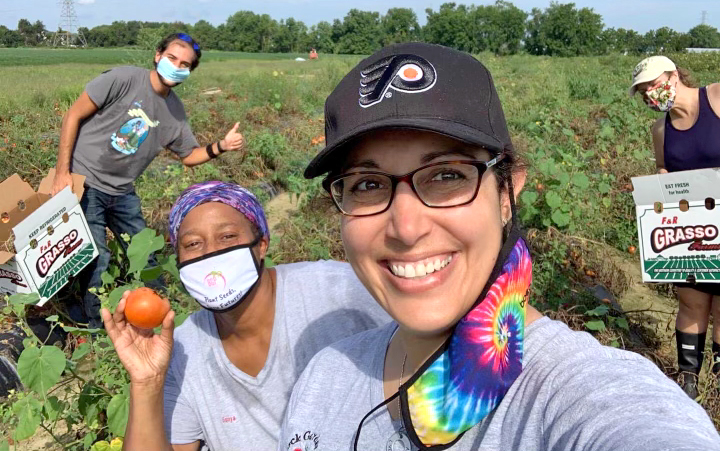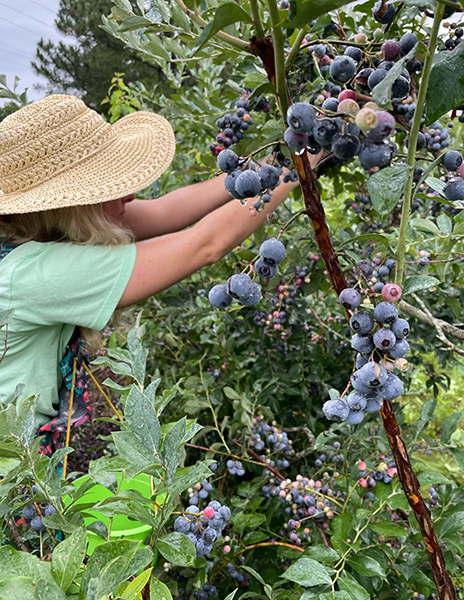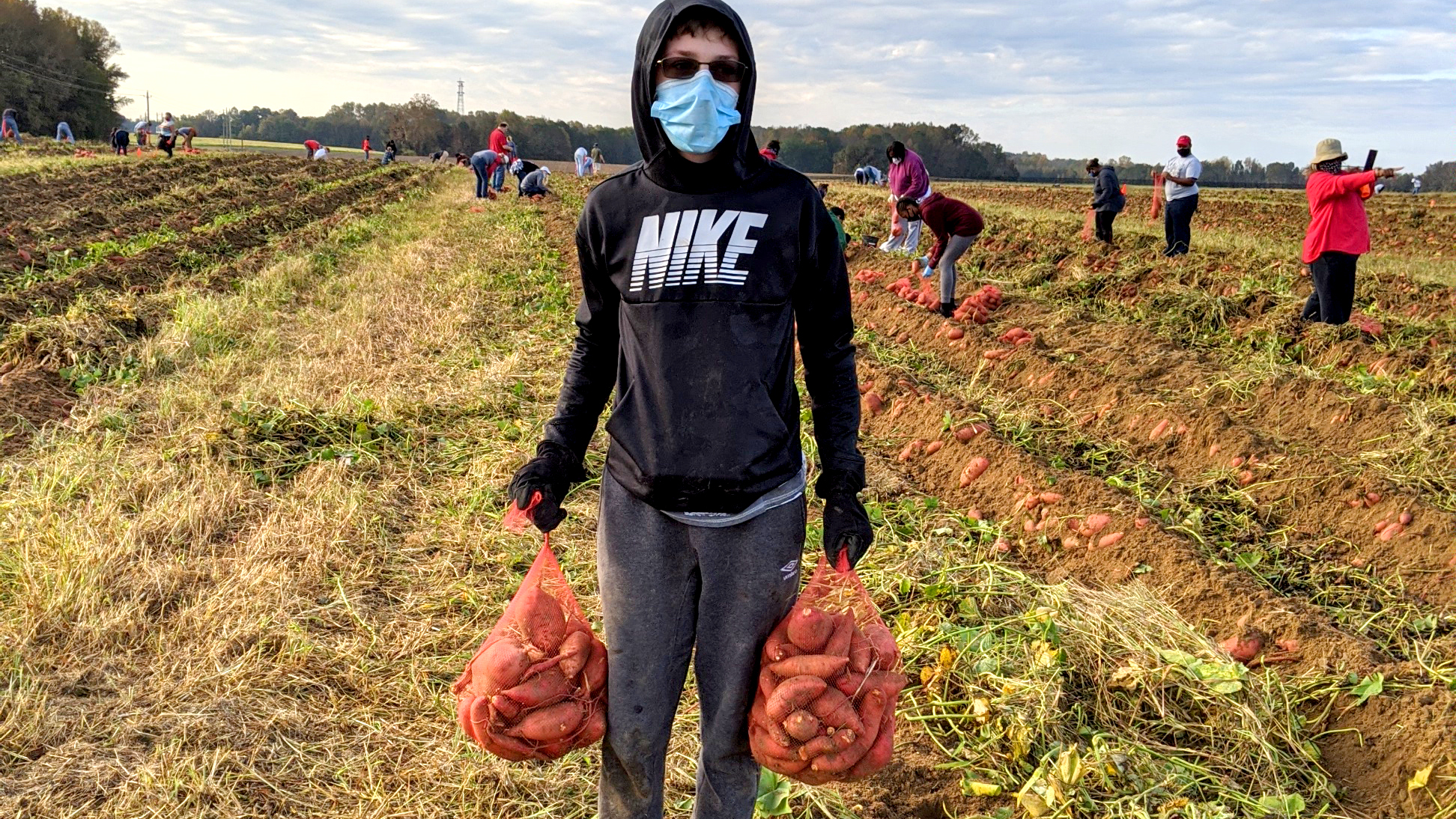Top: The Society of Saint Andrew (SoSA)’s gleaning program involves picking, gathering, bagging and moving bagged food from the fields to trucks waiting at the edge of the field, for delivery later that day to agencies feeding families in the community. Photo courtesy of SoSA
Kim Charick and Thomas O’Donnell
The ”Producers” data in the ReFED Insights Engine (ReFED, 2021) reported that 24.14 billion pounds of edible produce was left on American farms in 2019 — a multibillion dollar lost revenue stream to farmers and businesses. Of significance, the losses are not the same among different crops. For example, the World Wildlife Foundation (WWF) found that tomatoes, peaches, and romaine lettuce were lost at rates between 40% and 56%; potatoes, on the other hand, were only lost at a 3% rate (WWF, 2020).

Grasso Girls Farm in Mullica Hill, New Jersey partners with Bullock Garden Project’s (BGP) Fresh and Glean Initiative. Photo courtesy of Greg Newman, BGP
Also in 2019, the U.S. Department of Agriculture (USDA, 2019) reported that over 35 million people were food insecure. That is about 11% of the population and includes nearly 11 million children. Food insecurity is felt in every county across the United States (Feeding America, 2021). The American Heart Association found that “…. poor dietary habits are a leading cause of death and disability” (AHA, 2021). Unfortunately, in less than 10 years, about 50% of Americans are expected to suffer from obesity (Zachary, et al., 2019). The Centers for Disease Control reports that only 1 in 10 Americans eat enough fruits and vegetables.
From a resource perspective, food loss and waste uses about the same amount of water and energy each year as 50 million households (Vittuaria, et al., 2020). It also uses about the same amount of farmland as the production from 139 million acres of land, equivalent to the area of Florida, Georgia and the Carolinas combined (Read, et al., 2020). The produce being left to rot on American farms could just be the source of food that can help alleviate all these chronic problems. And really, it should not be too difficult to further optimize our food system so more produce stays in the food system to reach people.
Solutions — Gleaning, Harvest Support, and Revenue

Society of Saint Andrew volunteers are invited to glean after farmers finish the commercial harvest. Photo courtesy of SoSA
During FY2021, the U.S. Environmental Protection Agency funded several projects intended to create and demonstrate new ways for people living in limited food access areas to purchase surplus farm food while avoiding food loss. EPA is testing and searching for solutions that bring fresh produce to people in vulnerable communities who can afford to purchase it at attractive, discounted prices. These are likely to be new market demands, thereby not in competition with existing farm market channels. Often these are household consumers that do not qualify for SNAP or other food and nutrition support programs but still cannot access the produce that they and their families want and need.
The solutions are economically motivated, unlike most hunger relief projects that deliver food to charitable, nonprofit organizations. Each project then seeks to help people that are marginally food secure whose health needs are challenged by access and affordability. Solutions highlighted below link important networks such as food loss, data and policy, farm harvesting, logistics and jobs, technology and end-markets, and efficiency. These projects are challenging the involved organizations to figure out how to make this “new” food system work to the health, environmental, and financial benefit of everyone involved.
- Bullock Garden Project (BGP) Fresh and Glean Initiative: The BGP team works within the Southern New Jersey regional farm shed. With EPA’s grant funding, it will use an innovative technology platform provided by Forager, Inc. to connect locally gleaned produce to local buyers, initially focusing on lower income communities in Philadelphia (PA). The project will create a local farmer network to sell some of their surplus to local buyers who want to take advantage of fresh produce at local market prices. Gleaning and logistics are currently provided by the BGP team; however, they are working to create new business and job opportunities based on sharing the revenue stream that the surplus provides.
- Society of Saint Andrew Row by Row Research Project: Surplus produce from farms raising the most prominent food crops in Tennessee will be measured during the 2021 growing season using methods developed by Johnson et al. (2018). This information will then be used to develop a data-driven understanding of on-farm food loss by crop type as well as the economic value of on-farm food loss by county. Information will also be used to create an interactive map for the state of Tennessee’s food system, which can be used to support new policies for loss prevention, economic development, revenue for local farms, and agri-system jobs programs.
- Food Recovery Network: Thís is a pilot project in the Atlanta (GA) area that aims to reduce farm food loss and feed vulnerable communities, while putting in place a financially sustainable model. This pilot utilizes the student-originated Food Recovery Network and its ability to educate, gather and deploy student chapters for gleaning harvested or unharvested produce, develop relationships with farmers, and identify new buyers. Creating more access for surplus produce in Atlanta neighborhoods will provide new ways to access fresh, local farm surplus at more affordable prices.
- 4Roots: The 4Roots Farm’s project in Central Florida is designed to strengthen the local food economy by connecting farm supply to food demand. 4Roots, as a buyer and distributor, has partnered with farmers across central Florida and will leverage these relationships to purchase a farmer’s surplus supply of produce that they are unable to sell through their normal outlets. 4Roots will then utilize its relationships with local community organizations to improve access in food deserts through various distribution channels. 4Roots will sell the produce to existing and new sales outlets at a marginal markup, with profits going back into their programs to purchase more produce and sustain staff salaries.
- United Against Poverty UP Mobile Market Pilot: The UP Mobile Market pilot project connects farmers to communities in Orange, St. Lucie, and Indian River Counties in Florida. By creating a meaningful connection to communities in great need, a sustainable food access point can be replicated in other communities with reliable frequency. The goal is a demonstrated earned revenue model that supports financial sustainability while creating new jobs in the communities served, improving income levels of those that are living below poverty, increasing the number of people lifted to self-sufficiency each year, and providing nutritious food products at substantial savings.
- Association of Gleaning Organizations (AGO): AGO is a national nonprofit organization that provides training and strategies to improve and grow the gleaning movement to feed the most vulnerable people across American communities, protect the climate, and reduce food waste. The goal of this project is to offer technical assistance and training to gleaners in the southeast U.S. The project will include outreach to all gleaners, technical assistance for capacity building, funding, and many hours of dedicated one-on-one support.
The U.S. EPA had a “virtual booth” at the International Gleaning Symposium 2021.Video presentations and more by people directly involved in this gleaning work can be accessed at this link. The pilot projects are targeted to end by June 30, 2022. Information resulting from the work will be disseminated using various venues including social media, publications, webinars, conference proceedings at local and national levels, and other opportunities as they arise.
Kim Charick is with the U. S. Environmental Protection Agency in Atlanta, and Thomas O’Donnell is with the U. S. Environmental Protection Agency (NAHE) in Philadelphia. Any views expressed in this report do not necessarily represent those of the United States government or the Environmental Protection Agency. Mention of trade names or commercial products does not constitute endorsement or recommendation for use.













